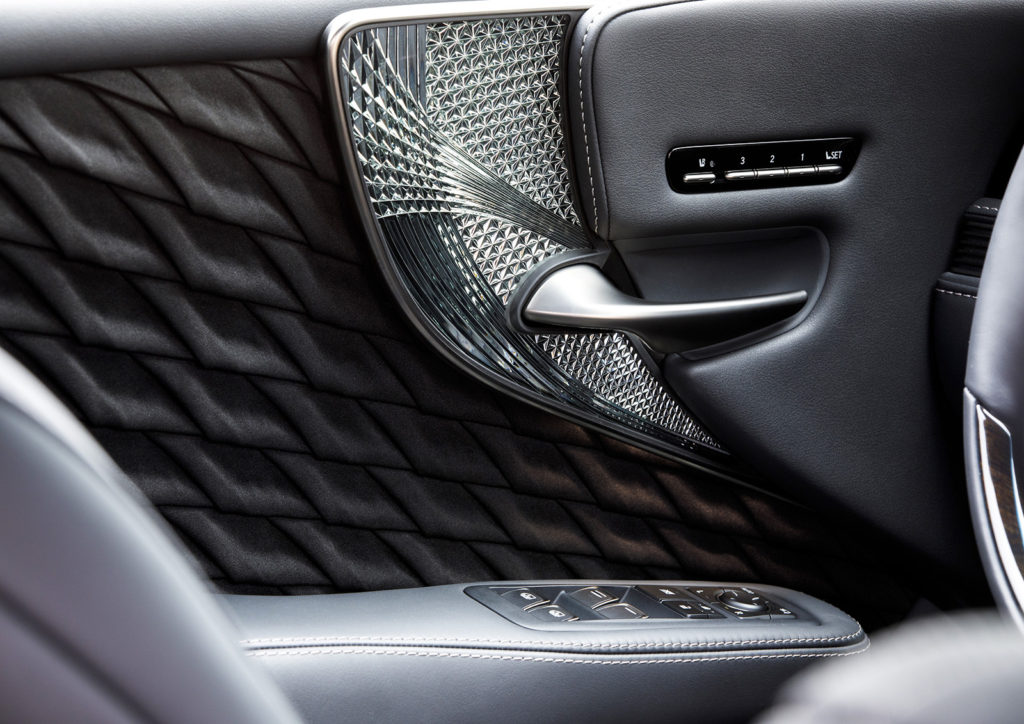Cargazing
By Derek Price
That’s an odd place to stake out your luxury brand’s ambition, seeing how the movable door has been commonplace in cars since the early 1920s. Lexus is taking the lowly door to a place it’s never been before now, and it’s doing so in a uniquely Japanese way.
An outrageously expensive option on my test vehicle, the “executive package with Kiriko glass” priced at $23,060, includes the most beautiful door trim I’ve ever seen on a vehicle. The handle is surrounded by a swath of intricately cut glass that radiates in sunlight like it belongs in a modern sculpture garden, but it looks traditional enough that Grandma would want it in her curio cabinet.
As if that weren’t over-the-top enough, Lexus spent four years perfecting a way of pleating the door upholstery to create a dramatic, origami-like look.

The LS, Lexus top-of-range luxury sedan, is completely redesigned for 2018. It includes a new focus on its Japanese heritage and the most aggressive look in the car’s history.
Keep in mind, that one package costs nearly as much as a brand-new 2019 Camry. I can’t imagine Lexus will sell more than a handful of upgrades at that price. The fact that they offer it, though, speaks volumes about the aspirations of this big sedan.
By combining the traditional Japanese art glass with the labor-intensive pleating that can only be done by hand, Lexus is appealing to buyers who see cars as an art form — the people who might be stepping down from a Rolls-Royce rather than up from a Buick.
That includes a back seat fit for royalty. With the executive package, the right rear seat can recline with an ottoman to rest your feet. It even has a built-in shiatsu massager to melt away your stress and a flock of tiny window shades that deploy electronically at the push of a button.
While very few buyers will likely opt for those pricey upgrades, even the entry-level LS — priced from $75,200 — feels in many ways like a rolling piece of art.
Its new body is both sensual and athletic, and its cabin is the most striking I’ve seen unveiled in a production car recently. The quality of its finishes and thoughtfulness of its design, right down to the sweeping shape of the interior door handles, sets it apart from more mundane competitors.
While the technology it deploys is impressive, including beautiful graphics and fast response from its eye-catching digital screen at the top of the dash, I can’t help but wish for a better interface than the laptop-style touchpad Lexus forces you to use. A simple touchscreen seems to do the job better.
Because this is a luxury flagship designed for a new generation of buyers, an old-style V8 under the hood will no longer suffice. Lexus dumped the LS’ previous engine for one with a more contemporary layout: six cylinders and twin turbochargers.

Cut glass and hand-made, pleated upholstery are part of a $23,060 upgrade to the new Lexus LS. The package includes heated and cooled massaging rear seats with an ottoman for passengers to rest their feet, among other luxuries.
While I miss the unmistakable grunt and roar of a naturally aspirated V8, I can’t argue with both the performance and the fuel economy of its new 3.5-liter engine. It makes 416 horsepower and 442 pound-feet of torque, enough to make the roomy beast feel sprightly.
My tester, a hybrid version with less horsepower in exchange for more save-the-Earth credibility, made 354 horsepower yet still earned fuel economy ratings of 23 mpg in city driving and 31 on the highway. That’s not bad at all for an all-wheel-drive, quick, powerful, substantial luxury vehicle.
What you can’t tell from numbers or features lists, though, is the way this car proudly embraces its Japanese origins. Just like the great German luxury sedans show off their engineering wizardry and Autobahn-inspired performance, and the great British sedans embrace Old World clubbiness with acres of polished wood, I believe this car is setting a new standard for what it means to be Japanese.
It goes far beyond precise build quality in efficient factories. The new LS is about heritage and craftsmanship. It’s about a truly unique sense of design, one that’s more original than derivative. It’s about walking with a quiet swagger.
And while the whole car carries that air, you only have to peek in one place to see the story unfold: those ridiculously over-the-top doors.
2018 Lexus LS 500h ($82,730). Options: Lexus Safety System + ($3,000), adaptive variable air suspension ($1,500), 20-inch wheels ($2,450), heads-up display ($1,200), LED headlamps ($300), executive package with kiriko glass ($23,060), Mark Levinson audio system ($1,940), panoramic view monitor ($800), heated wood and leather steering wheel ($410). Price as tested (including $995 destination charge): $118,385
Wheelbase: 123 in.
Length: 206.1 in.
Width: 74.8 in.
Height: 57.9 in.
Powertrain: V6 engine plus electric motors (354 total system horsepower)
Transmission: Multi-stage hybrid
Fuel economy: 23 city, 31 highway
RATINGS
Style: 10
Performance: 9
Price: 6
Handling: 7
Ride: 8
Comfort: 9
Quality: 9
Overall: 9
Why buy it?
This year introduces an all-new design for one of the world’s best luxury cars. It has a renewed sense of Japanese artistry and design, along with a twin-turbocharged engine and fresh technology that brings it firmly into the modern era.
